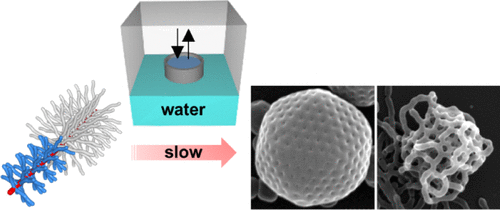当前位置:
X-MOL 学术
›
Macromolecules
›
论文详情
Our official English website, www.x-mol.net, welcomes your feedback! (Note: you will need to create a separate account there.)
Self-Assembly of Bottlebrush Block Copolymers into Triply Periodic Nanostructures in a Dilute Solution
Macromolecules ( IF 5.5 ) Pub Date : 2020-01-15 , DOI: 10.1021/acs.macromol.9b01662 Hyunji Ma 1 , Kyoung Taek Kim 1
Macromolecules ( IF 5.5 ) Pub Date : 2020-01-15 , DOI: 10.1021/acs.macromol.9b01662 Hyunji Ma 1 , Kyoung Taek Kim 1
Affiliation

|
Bottlebrush block copolymers (BBCPs) exhibit a distinct brush-like topology, which extends their conformations and, consequently, limits chain–chain entanglement in bulk forms and in concentrated solutions. These characteristics make them attractive building blocks to create well-defined nanostructures with large periodicities by self-assembly. However, self-assembly of BBCPs into periodic nanostructures in a dilute solution has rarely been studied. Here, we report the solution self-assembly of amphiphilic BBCPs with poly(ethylene glycol) (PEG) and polystyrene (PS) as pendants attached to a polynorbornene backbone. Similar to the self-assembly of conventional linear block copolymers (BCPs), the BBCPs underwent a morphological transition from spherical micelles to vesicles as their brush ratio, defined by the weight fraction of hydrophilic PEG brushes compared to the weight of the block copolymer brushes (wPEG), decreased. We found that the BBCPs self-assembled into inverse mesophases when the value of wPEG was below 7%. In particular, highly symmetric icosahedral cubosomes of BBCPs with internal double diamond lattices were formed when allowed to undergo self-assembly for an extended time period. This condition led us to find that new morphologies from self-assembly of BBCPs in a dilute solution, such as nanotubes and tubular networks, were analogous to the reticulated cylindrical micelles observed from the nonergodic assembly of linear BCPs. Our results suggested that BBCPs could serve a class of macromolecular building blocks to create complex nanostructures with unusual morphologies.
中文翻译:

在稀溶液中将刷毛嵌段共聚物自组装成三重周期性的纳米结构
洗瓶嵌段共聚物(BBCP)表现出独特的刷状拓扑结构,可扩展其构象,因此可限制散装形式和浓溶液中的链间缠结。这些特性使它们成为有吸引力的构建基块,可以通过自组装来创建具有大周期性的轮廓分明的纳米结构。但是,很少有人研究将BBCPs自组装成稀溶液中的周期性纳米结构。在这里,我们报告了两亲性BBCP的溶液自组装,其中聚(乙二醇)(PEG)和聚苯乙烯(PS)为侧链连接到聚降冰片烯骨架上。与常规线性嵌段共聚物(BCP)的自组装相似,BBCP经历了从球形胶束到囊泡的形态转变,这是它们的刷子比率,w PEG)降低。我们发现当w PEG的值低于7%时,BBCPs自组装成反中间相。特别地,当允许其经历长时间的自组装时,形成具有内部双菱形晶格的BBCP的高度对称的二十面体立方体。这种条件使我们发现,在稀溶液中,BBCP的自组装会产生新的形态,例如纳米管和管状网络,类似于线性BCP的非遍历组装观察到的网状圆柱形胶束。我们的研究结果表明,BBCP可以充当一类大分子构件,以创建具有异常形态的复杂纳米结构。
更新日期:2020-01-16
中文翻译:

在稀溶液中将刷毛嵌段共聚物自组装成三重周期性的纳米结构
洗瓶嵌段共聚物(BBCP)表现出独特的刷状拓扑结构,可扩展其构象,因此可限制散装形式和浓溶液中的链间缠结。这些特性使它们成为有吸引力的构建基块,可以通过自组装来创建具有大周期性的轮廓分明的纳米结构。但是,很少有人研究将BBCPs自组装成稀溶液中的周期性纳米结构。在这里,我们报告了两亲性BBCP的溶液自组装,其中聚(乙二醇)(PEG)和聚苯乙烯(PS)为侧链连接到聚降冰片烯骨架上。与常规线性嵌段共聚物(BCP)的自组装相似,BBCP经历了从球形胶束到囊泡的形态转变,这是它们的刷子比率,w PEG)降低。我们发现当w PEG的值低于7%时,BBCPs自组装成反中间相。特别地,当允许其经历长时间的自组装时,形成具有内部双菱形晶格的BBCP的高度对称的二十面体立方体。这种条件使我们发现,在稀溶液中,BBCP的自组装会产生新的形态,例如纳米管和管状网络,类似于线性BCP的非遍历组装观察到的网状圆柱形胶束。我们的研究结果表明,BBCP可以充当一类大分子构件,以创建具有异常形态的复杂纳米结构。


























 京公网安备 11010802027423号
京公网安备 11010802027423号